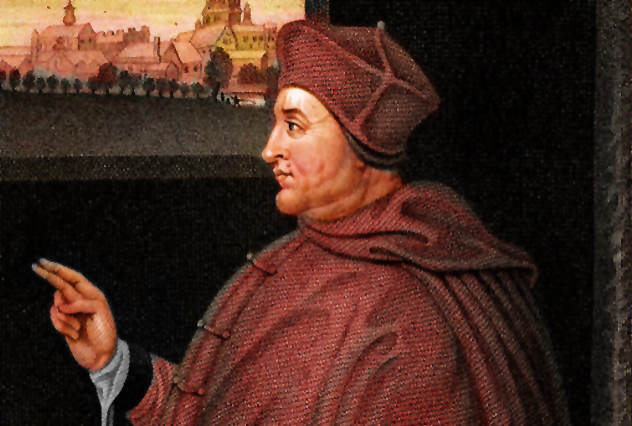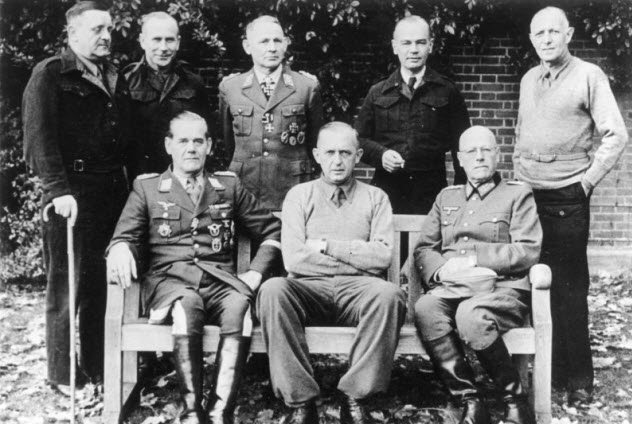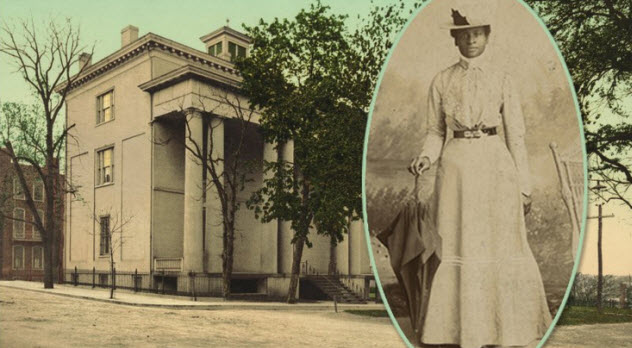 Music
Music  Music
Music  History
History 10 Less Than Jolly Events That Occurred on December 25
 Weird Stuff
Weird Stuff 10 Funny Ways That Researchers Overthink Christmas
 Politics
Politics 10 Political Scandals That Sent Crowds Into the Streets
 Weird Stuff
Weird Stuff Ten Bizarre Facts About The Doge Meme
 Our World
Our World 10 Ways Your Christmas Tree Is More Lit Than You Think
 Movies and TV
Movies and TV The 10 Coolest Stars to Set Sail on The Love Boat
 History
History 10 Things You Didn’t Know About the American National Anthem
 Technology
Technology Top 10 Everyday Tech Buzzwords That Hide a Darker Past
 Humans
Humans 10 Everyday Human Behaviors That Are Actually Survival Instincts
 Music
Music 10 Surprising Origin Stories of Your Favorite Holiday Songs
 History
History 10 Less Than Jolly Events That Occurred on December 25
 Weird Stuff
Weird Stuff 10 Funny Ways That Researchers Overthink Christmas
Who's Behind Listverse?

Jamie Frater
Head Editor
Jamie founded Listverse due to an insatiable desire to share fascinating, obscure, and bizarre facts. He has been a guest speaker on numerous national radio and television stations and is a five time published author.
More About Us Politics
Politics 10 Political Scandals That Sent Crowds Into the Streets
 Weird Stuff
Weird Stuff Ten Bizarre Facts About The Doge Meme
 Our World
Our World 10 Ways Your Christmas Tree Is More Lit Than You Think
 Movies and TV
Movies and TV The 10 Coolest Stars to Set Sail on The Love Boat
 History
History 10 Things You Didn’t Know About the American National Anthem
 Technology
Technology Top 10 Everyday Tech Buzzwords That Hide a Darker Past
 Humans
Humans 10 Everyday Human Behaviors That Are Actually Survival Instincts
10 Ways Secret Intelligence Was Gathered In The Past
A large part of every conflict is gathering information about the other side. Throughout history, people have had to formulate crafty methods to get the vital intelligence they needed. The stories about how and what they did make for an interesting perspective of the past.
10 Ham Common Torture

Recently, controversy has centered around the use of torture—or “enhanced interrogation”—to get information from suspected terrorists. But it’s not a new tactic.
As part of World War II’s Operation Fortitude—the plan to deceive the Germans about the D-day landing location—the SIS (British Intelligence) held 19 German agents in a cellar in a home in Ham Common. The German agents were “turned” into double agents through sleep deprivation and gross physical and mental abuse that was in direct violation of the Geneva Convention.
Subsequently, they began to share information about the German military while sabotaging the Nazis at the same time. They told the Abwehr (German Intelligence) that the invasion would land in Pas de Calais rather than Normandy Beach. These German agents continued to cooperate with the SIS until the end of the war.
9 World War I Sardines

World War I was the start of several intelligence and counterintelligence activities by world powers. One ingenious method by the Germans was the use of sardine shipments.
Ludovico Zender was a native of Lima, Peru, and the son of Norwegian immigrants. In 1914, he arrived in Glasgow as a “tradesman.” Zender ordered a large shipment of Norwegian sardines in 1915, claiming to be taking them back to Peru.
However, the telegrams sent by Zender went to Oslo, a known drop site for German intelligence. Zender’s operation was exposed because it was the wrong season for sardines. In actuality, his telegrams were descriptions of British shipping movements disguised as sardine transactions. Zender was convicted of espionage and executed at the Tower of London in 1916—the last spy to be executed there during World War I.
8 Silver Bullets

During the American War of Independence, both sides devised brilliant techniques to smuggle information back and forth. One technique was writing on tissue paper and stuffing the message into small objects like hollowed buttons, quills, or small silver balls resembling musket balls. These objects could easily be swallowed if the messenger was caught.
In 1777, British spy Daniel Taylor was entrusted with delivering a message from General Henry Clinton to General John Burgoyne. It was stuffed inside a silver ball the size of a cranberry.
When Taylor was caught by an American sentinel, they observed him swallowing an object. They forced him to consume tartar emetic to vomit up the bullet. “Out of his own mouth,” he was convicted as a spy and hanged.
7 Musical Spies

In medieval times, most elite musicians made money by touring and performing in the courts of royalty. Since they were thought of as entertainers and nothing more, they were the perfect candidates to become spies.
Such was the case of spy Pierre Alamire, a celebrated musician and composer of beloved choir books, who was recruited by Henry VIII’s adviser Cardinal Thomas Wolsey (pictured) in 1515. Alamire was to gather information about Richard de la Pole, a loyal Yorkist during the War of the Roses who later allied with the French to wage war against the English.
Alamire traveled to Metz, France, where Pole was living. In a strange twist, Alamire became a double agent and began passing information to both courts. He was no longer trusted by the English and, after 1516, never returned to England.
6 Pancho Villa’s Mormon Cowboy

During the Mexican Revolution, Pancho Villa was forced to find friends at every turn to stay one step ahead of those who wanted him dead. One unlikely ally was a Mormon trader named Jess Taylor. Villa’s enemies were known to raid Mormon colonies in Mexico, stealing supplies and holding captives for ransom.
Villa agreed to help Taylor with these colonies if Taylor could show Villa the locations of the enemy. Taylor, who appeared to be an ordinary cowboy, raised no suspicion while he was leading Villa and his army to the enemy. They were successful in their efforts, and Villa remained forever indebted to the Mormon cowboy.
5 Captain Allan McLane’s Disguises

When George Washington needed vital information during the American Revolutionary War, he dispatched his bravest spy—Captain Allan McLane. Captain McLane had caught Washington’s attention by distinguishing himself on the battlefield. He was then appointed to be an intelligence gatherer, which would remain his biggest priority from 1777 to 1782.
Twice, McLane disguised himself and went behind enemy lines. He first did so when Washington needed information on where the British planned to go after leaving Philadelphia in 1778. Disguised as a farmer, McLane pretended to wander into a British camp in New Jersey. He gained access and gathered the appropriate information.
Soon afterward, Washington successfully attacked at Monmouth Courthouse. Later, McLane disguised himself as a country bumpkin and entered the Stony Point Fort, which the British had taken. From what he saw, he created a bayonet battle plan which allowed the Americans to take the fort in only 25 minutes.
4 The Nazi Generals At Trent Park

During World War II, Nazi generals who were captured by the British were treated with incredible kindness—or so they thought. At one time, around 59 Nazi generals were held as prisoners in a luxurious home named Trent Park. There, they were fed good food and generally given whatever they desired. They thought that they had managed to get a good deal as POWs, but little did they know that their every word was overheard by British intelligence.
Inside Trent Park was an “M room” where German refugees worked with British intelligence to listen to the generals’ conversations. The information they gained was crucial. As Winston Churchill acknowledged, “If it wasn’t for this bugging operation, we may well have not won the war.”
Some of the things learned at Trent Park were the location of a secretive V-2 rocket site, facts about vital military technology, and the abuse of Jews by the Nazis.
3 Gossiping Gertrude Bell

A few months before World War I, Turkish authorities permitted British archaeologist Gertrude Bell to explore in Constantinople. She went to the city of Hail, which hadn’t been reached by Westerners since 1893. Although she appeared to be traveling for archaeological purposes, she really went to the city because it served as the capital of the brutal al Rashids and the British wanted to know their strength.
Upon arriving, Bell was imprisoned, but a personal code of honor among the Rashids kept them from harming her. She began to ingratiate herself among their polygamous wives and listened to their gossip. They so casually shared their intrigues and personal information that Bell was able to report to the British that the Rashids were weakening and the British should ally with the Saudis.
This policy recommendation to the British after the fall of the Ottoman Empire influenced the fate of the Middle East for the next century.
2 The Black Spies Of The Confederate White House

Throughout the Civil War, Jefferson Davis and his wife, Varina, lived in their own White House in the Confederate capital of Richmond, Virginia. Little did they know that every bit of their lives was watched and listened to quietly by their black servants.
William Jackson, their coachman, escaped the Davis home in 1862 and went to a federal camp where he divulged details of Davis’s plans for the war. Jackson said, “He plans advances, but [his generals] execute masterly retreats.”
Another slave-spy in the Davis home was Mary Elizabeth Bowser, who worked with an extensive Union spy network run by Richmond socialite Elizabeth Van Lew. It seems that Mary was installed as a waitress at the Davis home, and her efforts along with others by Van Lew provided valuable military information to the Union.
1 Sylvanus Morley
US Spy And Archaeologist

During World War I, archaeologist Sylvanus Morley played a seminal role in preventing German interests in Mexico, which could have drastically altered the course of history. A Mayanist, Morley traveled through Central America photographing ancient ruins and structures.
In 1917, he arrived in Honduras and attempted to photograph an old Spanish fort along the coast. When soldiers stopped him, he had to argue all the way up to the Honduran president before he was allowed to continue his activity. Little did they know that he was identifying German agents, photographing submarines, and hunting German shortwave broadcasts.
In all, he traveled 3,200 kilometers (2,000 mi) while documenting the German presence in Central America. Because of his efforts, Morley has been identified by historians as “arguably the best secret agent the United States produced during [World War I].” His method became the template for future efforts during World War II.
Gordon Gora is a struggling author who is desperately trying to make it. He is working on several projects, but until he finishes one, he will write for Listverse for his bread and butter. You can write him at [email protected].








